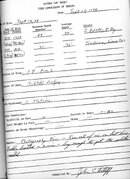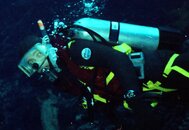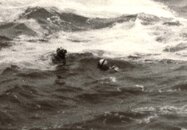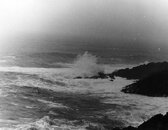You run out of air by not paying attention to your SPG. People who are diving deeper than normal and going through gas faster than expected are especially susceptible.I can see how that would be an issue if cave diving or getting lost inside a shipwreck etc, but in open water, how does someone just "run out of gas (air)"?
If the regulator broke and quit delivering air I think that could qualify, but I doubt if that happens very often.
You are using an out of date browser. It may not display this or other websites correctly.
You should upgrade or use an alternative browser.
You should upgrade or use an alternative browser.
Number one cause of diving fatalities?
- Thread starter Basking Ridge Diver
- Start date
Please register or login
Welcome to ScubaBoard, the world's largest scuba diving community. Registration is not required to read the forums, but we encourage you to join. Joining has its benefits and enables you to participate in the discussions.
Benefits of registering include
- Ability to post and comment on topics and discussions.
- A Free photo gallery to share your dive photos with the world.
- You can make this box go away
The head is about 15 pounds, but it's not fat, much less ugly fat. Very little fat, in fact, but it does have a lot of brain tissue. Weighting is important, and I used the above technique, on a full breath (and I have about a 7 liter lung capacity), so holding depth for a safety stop is not a problem for me on a tank with less than 750 psig. I have mostly gotten rid of my AL 3000 psig tanks, and am back to using steel tanks (double 42s, 45s, and 52s, and single 72s). For me, at my age, that is good enough.Your head is 15 pounds of ugly fat. Do you really want to be weighted so it will be out of the water with a tank that is low on air and no air in your BCD? If so, How do you hold a safety stop?
SeaRat
The head is about 15 pounds, but it's not fat, much less ugly fat. Very little fat, in fact, but it does have a lot of brain tissue. Weighting is important, and I used the above technique, on a full breath (and I have about a 7 liter lung capacity), so holding depth for a safety stop is not a problem for me on a tank with less than 750 psig. I have mostly gotten rid of my AL 3000 psig tanks, and am back to using steel tanks (double 42s, 45s, and 52s, and single 72s). For me, at my age, that is good enough.
SeaRat
Holding 15 lb above the water, fat or not, is roughly equivelent to your full lung capacity. by letting all air out you could sink but would rise if you let any air into your lungs. I don't like diving that way and I suspect you don't either.
KevinNM
Contributor
The local PADI courses I've observed while playing in their pool had people drop weight. multiple times in a class.My instructors used phrases like, "hold the belt in your hand, don't actually drop it because then we'll have to swim down and get it," and "hold the belt in your hand, don't drop it or you'll damage the coral."
"...by letting all air out you could sink but would rise if you let any air into your lungs..." Isn't that the definition of "neutral buoyancy"? I dive neutral, so I don't need my BCD much. Also, I don't hold my head out of the water much. That's why I usually dive with a snorkel (see the photo below). You'll not see my snorkel on my avitar, but that's because the photo was taken from a GoPro video I put together, and the GoPro, as well as my snorkel, are located on my dive helmet. I also wear a front-mount BCD, which I developed myself (and patented--the most expensive BC in the world, as no one bought the patent). If I want to stay afloat with my head out of the water, I simply inflate my Para-Sea BC.Holding 15 lb above the water, fat or not, is roughly equivelent to your full lung capacity. by letting all air out you could sink but would rise if you let any air into your lungs. I don't like diving that way and I suspect you don't either.
One of the advantages of the Para-Sea BC is that the only strap going around my waist is my weight belt, so it is easy to find in an emergency. (The tank harness is held by two straps that attach to a hip connector, as well as the shoulder straps; there is no waist strap for my Para-Sea BC setup on the tank harness.) I have had to ditch my weights in an emergency (which happened before I developed the Para-Sea BC concept), and relieved two divers of their weights in a different emergency.
Now, concerning running out of air at depth, what is the big deal? We are now telling our students and divers that if they run out of air at a depth of 60 or 80 feet, they're dead! That's nuts! Let me explain. Jacques-Yves Cousteau, in his first book, The Silent World, talked about the first diving courses that Frédéric Dumas taught in France. Here's what he said:
Unless you are decompression diving, or diving in an overhead environment, running out of air should not be a life-threatening situation. There's always the surface.Dumas planned the diving courses for the fleet aqualung divers, two of whom are to be carried on each French naval vessel. He immerses the novices first in shallow water to bring them through the fetal stage that took us years--that of seeinng through the clear window of the mask, experiencing the ease of automatic breathing, and learning that useless motion is the enemy of undersea swimming. On his second dive the trainee descends fifty feet on a rope and returns, getting a sense of pressure change and testing his ears. The instructor startles the class with the third lesson. The students go down with heavy weights and sit on the floor fifty feet down. The teacher removes his mask and passes it around the circle. He molds the mask again, full of water. One strong nasal exhalation blows all the water through the flanges of the mask. Then he bids the novices emulate him. They learn that it is easy to stop off their nasal passages while the mask is off and breathe as usual through the mouthgrip.
A subsequent lesson finds the class convened at the bottom and again their attendance is assured by weights. The professor removes his mask. Then he removes his mouthpiece, throws the breathing tube loop back over his head and unbuckles the aqualung harness. He lays all his diving equipment on the sand and stands naked except for his breechclout. With sure, unhurried gestures he resumes the equipment, blowing his mask and swallowing the cupfull of water in the breathing tubes. The demonstration is not difficult for a person who can hold a lungfull of air for a half minute.
By this time the scholars realize they are learning by example. They remove theyr diving equipment entirely, put it back on, and await the praise of the teacher. The next problem is that of removing all equipment and exchanging it among each other. People who do this gain confidence in their ability to live under the sea.
At the end of the course the honor students swim down to a hundred feet, remove all equipment and return to the surface naked. The baccalaureate is an enjoyable rite. As they soar with their original lungful, the air expands progressively in the journey through lessening pressures, issuing a continuous stream of bubbles from puckered lips.
Cousteau, Jacques-Yves, The Silent World, Harper & Brothers Publishers, New York, 1953, pages 179-180
Let me further illustrate from an old dive log of mine. We, the Oregon Department of Fish and Wildlife, were conducting subtidal clambed surveys using scuba to dredge a 2 foot square circle (that had to be calculated) in the bottom, and count the number, size and species of clams. I had been doing this all summer. On this September 15, 1975 dive, I actually made a total of 11 dives in the morning and afternoon of short duration, switching tanks between the morning and afternoon sessions. This was before we used SPGs, so we really did not know how much air was left in our cylinders. I ran out of air on my last dive to 35 feet. Here's what my dive log read:
I was shooting the photos, and would go over to Tom or Limons and get a couple of breaths, then back off a few feet and take some photos with my Nikonos with a 28mm lens. Then I came back for a couple more breaths. I don't recall now whether I buddy breathed up or made a swimming free ascent with them--I think I probably buddy breathed on the ascent.Photography Dives -- Ran out of air on last dive. Buddy breathed ~5 min -- long enough to get the photos needed.
To further illustrate this, I was scuba diving in our local competition pool. This pool is used for diving as well as swimming competitions, and is therefore 18 feet deep. It is also 25 yards wide, and 50 meters long. I simulated a regulator total failure by exhaling in the deep end at 18 feet, and simulating having to swim to the surface. If I swam across the pool, that would be 75 feet. But I swam diagonally across the deep end, which made the distance 80 feet plus. I was easily able to swim, and I was exhaling all the way even though I started without a full breath. The reason: there is quite a bit of expanding in the last fifteen feet of ascent, which is why a buoyant ascent is no longer recommended. (We did "blow and go" emergency ascents from about 25 feet using inflated Mae Wests as a part of the training in the U.S. Naval School for Underwater Swimmers.)
But my point is that running out of air is not running out of options. One shouldn't die because they ran out of air in water less than 100 feet deep, on a no-decompression dive.
SeaRat
Attachments
Last edited:
mattia_v
Contributor
The head is about 15 pounds, but it's not fat, much less ugly fat. Very little fat, in fact, but it does have a lot of brain tissue.
...over half said brain tissue, by mass, is structural lipids. i.e. fat ;-)
clownfishsydney
Contributor
I am aware of quite a number of people in Australia who died diving but who MAY well have survived had they dumped their weight belt, mostly at the surface. For example, a police officer who surfaced behind a boat out of air, then sank away. Weight belt on, no air. Another was a tech diver who probably used low O2 bottom mix on way down, became confused, surfaced but then sank away while he continued to breath the bottom mix (yes, even if he dropped weights he may have died). There are others in Australia that I am aware of, including one very close to this forum.
My guess is that the two divers who died in Victoria, Australia, this week will have been found to have not dropped their weights and also possibly ran out of air.
My view from all I have read and looked at (and in most cases there is not enough information known to come up with more than a guess) in order of causations of dive deaths are:
My guess is that the two divers who died in Victoria, Australia, this week will have been found to have not dropped their weights and also possibly ran out of air.
My view from all I have read and looked at (and in most cases there is not enough information known to come up with more than a guess) in order of causations of dive deaths are:
- Overweighting (and then in a lot of cases leading to the next one)
- Running low or out of air
- Panic (possibly set off by both of the above)
- IPO
- Other
...over half said brain tissue, by mass, is structural lipids. i.e. fat ;-)
So, where does the other 12 pounds come from....Despite weighing only about 3 pounds, the brain consumes as much as 20% of the oxygen and glucose taken in by the body...
Brain
SeaRat
You folks do realize that we are talking about Archimedes Principle here, don't you?
When the diver exhales, the chest shrinks, and the body becomes smaller. That volume change is greater than the volume of the exposed top of the head, so the weight of the body and gear is now greater than the volume of water being displaced, and the body sinks. Experience has shown that this will usually suffice to keep the diver submerged throughout the dive. As I said earlier, some people will add the amount of weight needed to compensate for the loss of the weight of the gas throughout the dive. This procedure needs also to be adjusted to some degree because of wet suit compression.
The upward buoyant force that is exerted on a body immersed in a fluid, whether fully or partially submerged, is equal to the weight of the fluid that the body displaces and it acts in the upward direction at the centre of mass of the displaced fluid.
The weight of the body displacing the water includes the entire body--in this case, even the head. If the weight of the entire body and gear is equal to the weight of that same amount of water, it will be completely immersed and neutrally buoyant. If the body and gear weigh less than that amount of water, then part of the body will be above the water line, and the part that is below the water line will be equal to the amount of weight it displaces.
When the diver exhales, the chest shrinks, and the body becomes smaller. That volume change is greater than the volume of the exposed top of the head, so the weight of the body and gear is now greater than the volume of water being displaced, and the body sinks. Experience has shown that this will usually suffice to keep the diver submerged throughout the dive. As I said earlier, some people will add the amount of weight needed to compensate for the loss of the weight of the gas throughout the dive. This procedure needs also to be adjusted to some degree because of wet suit compression.
John, and others, the problem with the head has to do with the panic a diver experiences, and tries to remain vertical in the water at the surface. This is the same response that happens when swimmers panic. The head's weight then works to push the swimmer/diver down. So head weight becomes a problem if the swimmer/diver tries to keep vertical and head up in the water. We used to call this the "panic/exhaustion syndrome."
But the diver has advantages, even when out-of-air, on the surface. Divers have fins, and a snorkel. But these only work well if the diver is not over-weighted, or becomes positively buoyant. Dropping weights will do that, as well as use of the BC (the combo is best).
I know what I'm talking about here, as my buddy and I once spent almost 4 hours in bad water conditions off the Oregon coast when the waves changed suddenly (when we were underwater) from 3-5 feet to 15-20 feet. We were rolled when trying to exit, and went back out to await pickup. I have a long paper on this, called "Anatomy of a Near Miss," which goes into detail. But suffice it to say, the two things that kept us alive were positive buoyancy and a buddy line that kept us together during the entire episode. That, and not panicking. The Coast Guard finally picked us up, and were really happy to get live pickups.
The below photos show us in the water before and after being rolled (by our girl friends on shore) and the conditions of the sea.
SeaRat
But the diver has advantages, even when out-of-air, on the surface. Divers have fins, and a snorkel. But these only work well if the diver is not over-weighted, or becomes positively buoyant. Dropping weights will do that, as well as use of the BC (the combo is best).
I know what I'm talking about here, as my buddy and I once spent almost 4 hours in bad water conditions off the Oregon coast when the waves changed suddenly (when we were underwater) from 3-5 feet to 15-20 feet. We were rolled when trying to exit, and went back out to await pickup. I have a long paper on this, called "Anatomy of a Near Miss," which goes into detail. But suffice it to say, the two things that kept us alive were positive buoyancy and a buddy line that kept us together during the entire episode. That, and not panicking. The Coast Guard finally picked us up, and were really happy to get live pickups.
The below photos show us in the water before and after being rolled (by our girl friends on shore) and the conditions of the sea.
SeaRat
Attachments
Similar threads
- Replies
- 0
- Views
- 284
- Replies
- 0
- Views
- 371
- Replies
- 6
- Views
- 1,100
- Replies
- 1
- Views
- 315
- Replies
- 4
- Views
- 657








